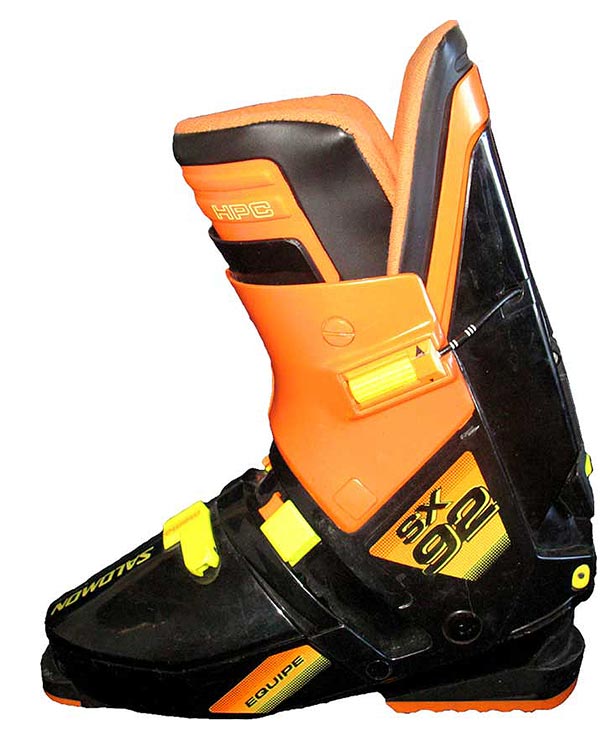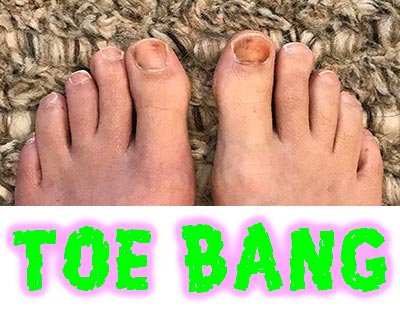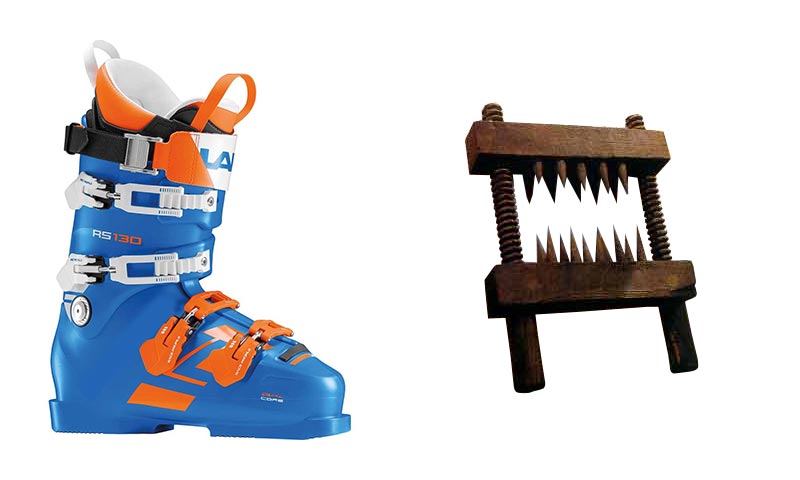Ask any skier what the worst aspect of the sport is and hand’s down, you’ll get the same response: the boots. Ski boots have made some small strides in terms of fit and technology over the past 30 years, but the reality is they should be better, a lot better. It’s 2019! There are self-driving cars! But the ski industry cannot figure out how to make boots that aren’t Medieval torture devices. Why? Why??!
The biggest problem is the whole boot fitting process. It’s just not designed for comfort.
If you go to a quality ski boot shop, you’ll hear that ski boots should not only fit your foot based on length, but also several other aspects, including volume. While this is true, it’s also more important to think about fit in terms of overall comfort, not performance. Sure if you’re Mikaela Shiffrin, you want your boots to fit incredibly tight so you can translate any lower body movement to the ski. But if you’re 99 out of 100 skiers out there, you don’t need this type of performance. You may think you need it or want to tell you friends you need it on the chairlift, but you don’t. What you need is a fit that will perform while being…wait for it…wait for it…comfortable.
I’ve been skiing for 33 years. Well, let me correct that…actually I was a pretty hardcore skier until I was 27 when I blew out my ACL on my left knee. The operation didn’t go so well, and it was a long recovery. I was living in Colorado at the time and was a hardcore on-piste/off-piste skier. Just when I was back up to speed, I tore my right ACL playing soccer. After another grueling year of recovery, I decided to try snowboarding, which was much less strain on my knees. I loved it. Not only did it completely open the mountain up (Green and Blue rated trails were fun again!), but snowboard boots were like wearing slippers on the mountain. Soft, gooey and comfy. Wow.

Twenty years later, I threw out my back and simply could not buckle in using traditional snowboard bindings. I tied Flow bindings / Gnu bindings and even the new Burton StepOn’s in order to make strapping in easier. But they all had shortcomings. With my son becoming a strong skier himself, I dug out my old Salomon ski boots, which were the most comfortable and warm boots back in the day, rented some skis and took to the slopes to see how it felt on the old body. The new parabolic skis allowed me to arc some sweet turns with minimal effort and my back didn’t hurt at all (my knees were another story…but it wasn’t something I couldn’t handle). While the Solomon SX92’s were comfortable, their heft made walking cumbersome and put strain on my weakened knees. Considering the advancement in gear, I decided it was time to source a pair of “modern” boots.
“A lot has changed, since you left skiing,” the boot fitting specialist told me at one of the better ski shops in Killington, Vermont. From heat moldable liners to a whole different fitting paradigm, which measured length, width, and volume, and looked at various foot types, as well as skier ability and the type of terrain you like to tackle when you hit the slopes. After sizing me with a specialized device, he had me put my bare foot inside of a boot shell without the liner. He asked me to position my toes so they were touching the front and looked at the space between my heel and the back of the boot. He then selected a shell that was a size or so smaller than my typical shoe size, re-inserted the liner and had me step in. My toes were crammed into the front and I informed him of the extreme discomfort. Don’t worry when we heat mold them and then they “pack in” they’ll be perfectBullsh!t.
They weren’t. In fact, they sucked. My toes were slamming into the front of my boots every single time I made a turn – no matter how much I cranked my bindings to keep my heel back. It was so bad that I got something called “toe bang.” Look it up. It’s actually a thing. And it’s such a big thing that there are entire discussions online about skiers discussing how uncomfortable their boots are that the toenails of their big toes became completely black and blue.

I ended up taking my boots back to the shop at least five times. Truth is, I stopped counting after the fifth time. Each time they shaved the liner, carved out the front of the boot plastic with a Dremel to create more space and then had me purchase expensive foot orthotic inserts to lift my heel to create more room in the front. After the last fruitless “refitting,” it dawned on me: If they simply fit me with a bigger shell, I would not be having ANY of these issues and my feet may have at least had a fighting chance to be comfortable. But every ski shop is fitting boots this way so it has to be correct, right? Wrong.
Just because other people are doing it, doesn’t mean it’s a good fit for you.
This ski boot fitting lunacy showcases that the industry has no idea what their customer really wants, but more importantly, why most people get to the point where they simply quit the sport, forcing the industry to lose years of additional revenue. The fact that there is a thriving secondary industry that takes advantage of skier’s discomfort with their boots should tell the manufacturers something. Or maybe that’s the scam. Sure you bought our ill-fitting boots, now buy a bunch of secondary products so that you can just barely tolerate the pain and discomfort. Insane.

The ski industry has this completely wrong and I’m here to tell you NOT to use this boot fitting methodology. If you have to endure pain and displeasure with boots that are “suspiciously snug” or give you “toe bang,” then there is something wrong. Especially when participating in an outdoor family activity that is supposed to be fun and pleasurable. When buying yourself new ski boots, make sure your toes do not touch the front of the boot. There should also be some space even when standing up straight (remember, you’re going to be doing a fair bit of walking around in these, no reason they should be painful during this part of the sport either).
Not only does this philosophy work for your ski boots, but it also works for your content marketing endeavors. For example, everyone may be telling you that you need to start making videos for your business. And that may be true if you’re creating rewarding content to attract new customers, but what if getting in front of the camera is uncomfortable, painful or gives you incredible anxiety? Should you still do it? No! Just because other people are doing it, doesn’t mean it’s a good fit for you. Because if you’re uncomfortable, that energy will corrupt your performance and be picked up by your viewers. You may be answering the question they’re dying to know the answer to, but they’ll never call your 800 number because “that guy in the video was really weird.”
You’re going to have to find a different vehicle for your original content. Maybe getting in front of a video camera is too overwhelming, but speaking into a microphone is no problem for you. Maybe your content vehicle should be a podcast? Or maybe you’re very good at photography? Taking pictures to assist potential customers along their Buyer’s Journey and putting them on Instagram could be a good avenue for you. The point is do what’s right and comfortable for you, not just what everyone else is doing.
